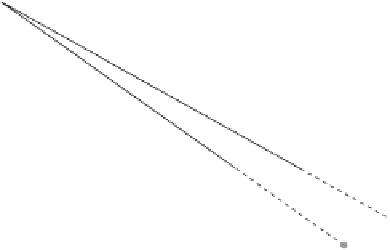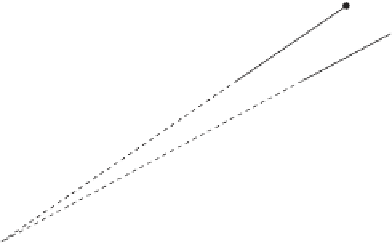Graphics Programs Reference
In-Depth Information
appear parallel, and seem to converge to a distant vanishing point on the far left of the
figure. In addition, the four lines that originally converged at the center of the cube
now converge to a vanishing point slightly to the right of center.
This small rotation has resulted in the same cube featuring two vanishing points.
It can be interpreted by saying that the rotation has moved the original vanishing point
slightly to the right and the new vanishing point isn't really new. It was originally
located at infinity and has moved by the rotation to a finite (albeit distant) location.
These observations should help the reader to understand and agree with the follow-
ing statement: In order for an object to feature vanishing points, it must have groups of
straight parallel lines. The lines may be generated by the intersection of two planes on
the object, as in the case of a cube, or they may be painted or scribed on the surface of
the object. They may even be located inside the object, if it is transparent. Any such
group of lines results in a vanishing point, except if the lines are perpendicular to the
line of sight of the viewer. Rotating the cube of Figure 3.8 has changed the orientation
of a group of four parallel lines that were originally perpendicular to the line of sight
but are no longer so. The new orientation has therefore added a vanishing point.
The conclusion is that an object may have any number of vanishing points depend-
ing on its shape and orientation, on groups of parallel lines that happen to be on it, and
on the direction from which it is viewed.
The statement above is the rule governing vanishing points. It should be stressed
that the vanishing points are not real. They exist only in our imagination and we
imagine them because of the particular way our brain interprets the signals sent from
our eyes.
Normal
A
B
θ
θ
Mirror
B
*
A
*
Figure 3.9: The Rule of Reflection.
An interesting example of vanishing points is a reflection in a mirror. A ray of
light that strikes a mirror is reflected in a direction determined by the normal to the
mirror. The rule of reflection (Figure 3.9) is that the angle of incidence equals the angle








Search WWH ::

Custom Search